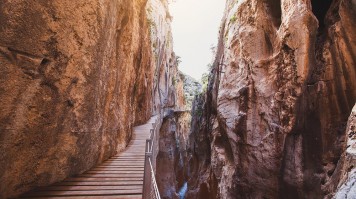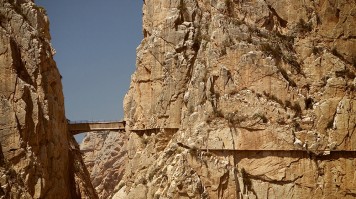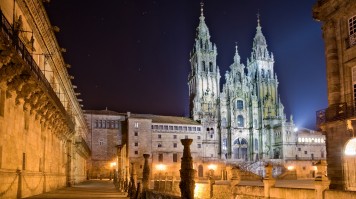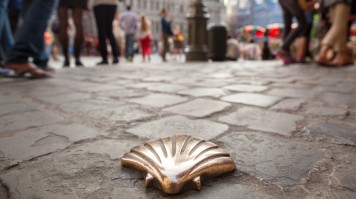Things to Do in Spain

- Adut
- From
- Adut
- From
- Hugh
- From
- Monica
- From
Construction of this breathtaking cathedral, dedicated to the Holy Family, first began in 1882 and still continues to this day. Legend has it that if Gaudi’s masterpiece of design is ever completed, the world will end, which is perhaps why it’s taking so long to finish! No trip to Spain is complete without a visit here. The cathedral is open daily, though restrictions apply during mass times. Be sure to dress appropriately and remember that some parts of the cathedral could be closed as construction continues.
Recommended activities:
- Take time to admire the intricate facades of the Sagrada Familia. Each facade tells a different part of the story of Christ's life.
- Climb the towers or take an elevator for breathtaking views of Barcelona. The Nativity and Passion facades have towers that are open to the public.
- Visit the museum inside the basilica to learn about the history and construction of La Sagrada Familia.
Best time to visit: Visit La Sagrada Familia in any season, But we recommend visiting early in the morning to avoid crowds.
Good to know: You can buy tickets for the cathedral online. A basic ticket costs around USD 26*, with more expensive options for audio guides, and the chance to go to the top of one of the cathedral’s towers, also available.
Insider's tip: Purchase skip-the-line tickets as the normal queue can get very long and better purchase in advance (around 3 to 5 days before your trip) so you can reserve a spot. It's good to visit this famous attraction when the sun is not so high up (around mid-morning or before sunset) so you can see its rays pass through the stained glass windows. You will be in awe of the beautiful colors glow inside the basilica because of the natural light. To learn more about its history, you can purchase an audio guide for a self-guided tour. — by Ed from Dubai Travel Blog


El Caminito del Rey, also known as ‘the King’s little pathway’ is a walkway straddling the side of the El Chorro gorge near Ardales in the province of Malaga. This is not an experience for the faint-hearted! Adrenaline junkies can traverse the 3-kilometre walk along a 1-meter wide path, 100 meters above the gorge floor below. Originally built as a route for workers at the hydroelectric power plant nearby, it now attracts thrill seekers from around the world. The path was closed for four years, reopening in 2015, following several deaths. Now though, it is possible to traverse the Caminito far more safely, but the excitement remains. As far as points of interest in Spain go this must be amongst the most hair-raising!
Recommended activities:
- Learn about Caminito del Rey’s history. The trails have information boards that provide insight into its construction and significance.
- Keep an eye out for local birdlife. The natural surroundings of Caminito del Rey are home to a variety of bird species including the Griffon vulture, golden eagle, and alpine swift.
Best time to visit: The best time to visit Caminito del Rey is during the spring season (March to June) when the flowers are in full bloom and the weather is pleasant.
Good to know: Tickets for the walk can be reserved online and cost around USD 12*. Guided walks are available, and you will need to be physically fit with a good head for heights!
Insider's tip: Book a few days in advance to secure the desired time-slot. Best go early to avoid the midday Mediterranean sun and bring plenty of water! Watch videos of daredevils taking old pathway on YouTube to understand why this was one of the most dangerous paths in the world. If time permits, be sure to take a detour to the quaint town of Ronda that’s only an hour’s drive away. It has an 18th-century bridge spanning over a 120M deep gorge that could take anyone’s breath away! — by Winny Wu from Travel with Winny
Find out more things to do in Malaga.


For those with an appetite for adventure, a hike along one of the numerous Camino pilgrimage trails to the city of Santiago de Compostela is a must. These ancient routes have been traversed by pilgrims for centuries. However, you don’t need to be religious to enjoy the sense of achievement and adventure that comes from following these long-distance footpaths across Northern Spain. Whether you walk for weeks and cover the entire route, or just take a few days to hike along some of the trails, you’ll find the challenge a rewarding one; after all, you will be following in the footsteps of thousands who have gone before. Just follow the white shells which mark the route!
Recommended activities:
- Visit the numerous churches, monasteries, cathedrals, and religious sites along the route. They feature beautiful artwork and many have historic value.
- Try the local dishes and specialties of the areas you pass through. Each region has its own culinary traditions for wines, cheeses, and dishes, like pulpo a la gallega (Galician-style octopus).
Best time to visit: The best months to visit the Camino Trail are May, June and September. The weather is pleasant during these months and rainfalls are less likely.
Good to know: There are numerous ways to walk the Camino. The most popular is the ‘Camino Frances’ which begins at St. Jean Pied de Port just across the border into France. It’s a good option for first-timers being well signposted, with plenty of accommodation en route.
Insider's tip: One of the best tips I can give before taking on the challenge that is the Camino, is to train. It's obviously difficult to train yourself to walk over a half marathon everyday for a month, but the more walking you can do before hand, the better position you'll find yourself in for success on the trail. That said, the Camino is a very 'come as you are' experience, and you can take as much time as you need; it's not a race, and no-one on the trail treats it as one. So even if you're not overly fit, if you've got time, you'll be fine. The only expectations you should travel with is that it will be challenging ... and that it will rain (so pack wet weather gear accordingly). — by Megan Jerrard from Mapping Megan
If a guided tour is your cup of tea, then our all-arranged Camino tours are for you!
Also, check out our list of famous Spanish dishes to eat in Spain! We also have plenty of food tours in Spain if you’d like to join one.
Recommended activities:
- Join the parade to get into the festive spirit. The event usually starts with a parade featuring music, dancing, and colorful costumes.
- Try some traditional Spanish food and drinks from local vendors. Sangria, paella, and tapas are popular choices.
- Many bars and restaurants in Buñol host live music performances and parties during La Tomatina. It's a great way to unwind after the tomato fight.
Best time to visit: The festival is held in August every year.
Good to know: The festival takes place on the last Wednesday in August. Accommodation in Bunol is booked up months in advance so if you’re planning to stay be sure to book well ahead.
If you have only 24 hours in Madrid, you need to visit Plaza Mayor, visit at least one museum like El Prado, explore the hipster neighbourhood of Chueca or Malasaña, have churros con chocolate in San Gines bar, tapas in La Latina neighbourhood and have dinner in the oldest restaurant in the world, El Botin. The suckling pig is their star dish! Eventually you’ll have the time to visit my favorite sight in Madrid: Templo Debod, an original Egyptian temple surrounded by a lush park offering beautiful views on Madrid and its parks. — by Paulina from Paulina on the Road
Take your pick from our list of Madrid tours.
Check out our guide on things to do in Granada for more attractions and activities in Granada.

There are countless world-class things to do for sightseeing in Barcelona, but exploring Gaudi’s fascinating monuments ranks among the best activities this bustling city has to offer. It’s hard not to miss Gaudi’s otherworldly architecture in the city — it pops out among the sea of neoclassical and modernist buildings. Characterized by brilliant colors and voluminous texture, Gaudi’s astonishing monuments pioneered the Catalan art nouveau movement and remain popular today thanks to their innovative design and alluring appeal.
Recommended stops:
- As the crown jewel of Gaudi’s work, the Sagrada Familia is an absolute must-see when visiting Barcelona. The futuristic basilica boasts a massive design characterized by avant-garde stonework structures and sculptures filtered out through colorful stained glass windows. True works of art are always evolving, and the Sagrada Familia is no exception; since its creation in 1882, the basilica is still unfinished to this day.
- Also known as La Pedrera, Casa Milá has an intriguing facade pulling inspiration from nature, but its best features lie in the home’s interior —- not to mention the otherworldly terrace with 360° views of Barcelona.
- If you want to experience the best views in Barcelona, head straight to Parc Güell. Astonishingly, the park’s stunning panorama isn’t even the best feature it has to offer—its creative curved and geometrical elements, along with its colorful mosaics, are what really steal the spotlight.
- Dreamy Casa Batlló is made of colorful curved tiles that resemble the waves of the sea or the back of an iguana. Its shimmering exterior and cutting-edge detail-oriented interior seamlessly blend beauty and functionality, creating a mystic atmosphere up for interpretation.
Best time to visit: Anytime. These attractions are open year-round.
Good to know: The Sagrada Familia is Spain’s most visited attraction, with Gaudi’s other architectural monuments ranking in as a close second. That means long lines are just as guaranteed as great views. To spare yourself hours in a queue, consider booking tickets online beforehand.
15. Celebrate one of the World’s Biggest Festivals, Las Fallas in Valencia

Of all the things to do in Valencia, the annual Las Fallas celebration remains among the most legendary. Get ready for a fun-filled week of next-level fireworks, colorful (and loud) gunpowder spectacles, and enchanting towering statues in nearly every charming street corner. Take your pictures by the whimsical monuments before the final day, though, when the detailed art pieces get burned to the ground in a dramatic and fun-filled closing ceremony that fills the city with sky-high bonfires around every block.
Recommended activities:
- Stop by the Plaza de la Virgen after the two-day Flower Ofrenda for a fabulous photo-op of a 15-meter flower-filled statue of the Virgin Mary.
- Catch the award-giving ceremony on March 17. With over 750 sculptures across Valencia, it’s an interesting, competitive, and culturally significant event.
- Don’t miss the ultimate firework display on the Nit del Foc, which is among the most sophisticated and carefully curated across the globe.
Best time to visit: Las Fallas occurs annually from March 15–19th, so be sure to book your tickets between those dates. If you can’t make it in time, no worries, you can still catch the mascletà, a dynamic pyrotechnic performance, in the Plaza del Ayuntamiento each afternoon starting March 1st.

